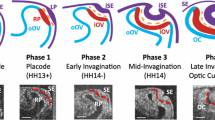Summary
Lens induction is a classic example of the tissue interactions that lead to cell specialization during early vertebrate development. Previous studies have shown that a large region of head ectoderm, but not trunk ectoderm, of 36 h (stage 10) chicken embryos retains the potential to form lenses and synthesize the protein δ-crystallin under some conditions. We have used polyacrylamide gel electrophoresis and fluorography to examine protein and glycoprotein synthesis in presumptive lens ectoderm and presumptive dorsal (trunk) epidermis to look for differentiation markers for these two regions prior to the appearance of δ-crystallin at 50 h. Although nearly all of the proteins incorporating3H-leucine were shared by presumptive lens ectoderm and trunk ectoderm, these two regions showed more dramatic differences in the incorporation of3H-sugars into glycoproteins. when non-lens head ectoderm that has a capacity for lens formation in vitro was labeled, a hybrid pattern of glycoprotein synthesis was discovered: glycoproteins found in either presumptive lens ectoderm or trunk ectoderm were oftentimes also found in other head ectoderm. Therefore, molecular markers have been identified for three regions of ectoderm committed to different fates (lens and skin), well before features of terminal differentiation begin to appear in the lens.
Similar content being viewed by others
References
Agata K, Yasuda K, Okada TS (1983) Gene coding for a lens-specific protein, δ-crystallin, is transcribed in nonlens tissues of chicken embryos. Dev Biol 100:222–226
Akers RM, Phillips CR, Wessels NK (1986) Expression of an epidermal antigen used to study tissue induction in the earlyXeno-pus laevis embryo. Science 231:613–616
Barabanov VM, Fedtsova NG (1982) The distribution of lens differentiating capacity in the head ectoderm of chick embryos. Differentiation 21:183–190
Beeley JG (1985) Glycoprotein and proteoglycan techniques. Elsevier, Amsterdam New York Oxford
Brahma S, Grunz H (1988) Crystallins duringXenopus laevis free lens formation. Roux's Arch Dev Biol 197:190–192
Charlebois TS, Spencer DH, Tarkington SK, Henry JJ, Grainger RM (1990) Isolation of a chick cytokeratin cDNA clone indicative of regional specialization in early embryonic ectoderm. Development 108:33–45
Fuchs E, Tyner AL, Giudice GJ, Marchuk D, RayChaudhury A, Rosenburg M (1987) The human keratin gene and their differential expression. Curr Top Dev Biol 22:5–34
Grainger RM, Henry JJ, Henderson RA (1988) Reinvestigation of the role of the optic vesicle in embryonic lens induction. Development 102:517–526
Gurdon JB (1987) Embryonic induction - molecular prospects. Development 99:285–306
Hamburger V, Hamilton HL (1951) A series of normal stages in the development of the chick embryo. J Morphol 88:49–92
Henry JJ, Grainger RM (1987) Inductive interactions in the spatial and temporal restriction of lens-forming potential in embryonic ectoderm of Xenopus laevis. Dev Biol 124:200–214
Henry JJ, Grainger RM (1990) Early tissue interactions leading to embryonic lens formation in Xenopus laevis. Dev Biol 141:149–163
Humason GL (1979) Animal Tissue Techniques. Freeman, San Francisco
Jacobson AG (1966) Inductive processes in embryonic development. Science 152:25–34
Jacobson AG, Sater AK (1988) Features of embryonic induction. Development 104:341–359
Karkinen-Jaaskelainen M (1978) Permissive and directive interactions in lens induction. J Embryol Exp Morphol 44:167–179
Laemmli UK (1970) Cleavage of structural proteins during assembly of the head of bacteriophage T4. Nature 227:680–685
Lewis W (1904) Experimental studies on the development of the eye in amphibia. II On the origin of the lens.Rana palustris. Am J Anat 3:505–536
Lewis W (1907) Lens formation from strange ectoderm inRana sylvatica. Am J Anat 7:145–169
Page M (1989) Changing patterns of cytokeratins and vimentin in the early chick embryo. Development 105:97–107
Saha MS, Spann CL, Grainger RM (1989) Embryonic lens induction: more than meets the optic vesicle. Cell Diff Dev 28:153–172
Saxen L, Lehtonen E, Karkinen-Jaaskelainen M, Nordling S, Wartiovaara J (1976) Are morphogenetic tissue interactions mediated by transmissible signal substances or through cell contacts? Nature 259:662–663
Shinohara T, Piatigorsky J (1976) Quantitation of δ-crystallin messenger RNA during lens induction in chick embryos. Proc Natl Acad Sci 73:2808–2812
Slack JMW (1984) Regional biosynthetic markers in early amphibian embryo. J Emb Exp Morphol 80:289–319
Slack JMW (1985) Peanut lectin receptors in the early amphibian embryo: regional markers for the study of embryonic induction. Cell 4:237–247
Smith JC, Watt FM (1985) Biochemical specificity ofXenopus notochord. Differentiation 29:109–115
Spemann H (1938) Embryonic development and induction. Yale University Press, New Haven
Sullivan CH, O'Farrell S, Grainger RM (1991) Delta-crystallin gene expression and patterns of hypomethylation demonstrate two levels of regulation for the delta-crystallin genes in embryonic chick tissues. Dev Biol (in press)
Weber K, Osborn M (1969) The reliability of molecular weight determinations by dodecyl-sulfate-polyacrylamide gel electrophoresis. J Biol Chem 244:4406–4412
Zelenka P, Piatigorsky J (1974) Isolation and in vitro translation of δ-crystallin mRNA from embryonic chick lens fibers. Proc Natl Acad Sci 71:1986–1900
Zwaan J, Ikeda A (1968) Macromolecular events during differentiation of the chicken lens. Exp Eye Res 7:301–311
Author information
Authors and Affiliations
Rights and permissions
About this article
Cite this article
Sullivan, C.H., Hart, J.P. & Kramer, J. The pattern of protein and glycoprotein synthesis in presumptive lens and non-lens ectoderm of the chicken embryo. Roux's Arch Dev Biol 200, 38–44 (1991). https://doi.org/10.1007/BF02457639
Accepted:
Issue Date:
DOI: https://doi.org/10.1007/BF02457639




